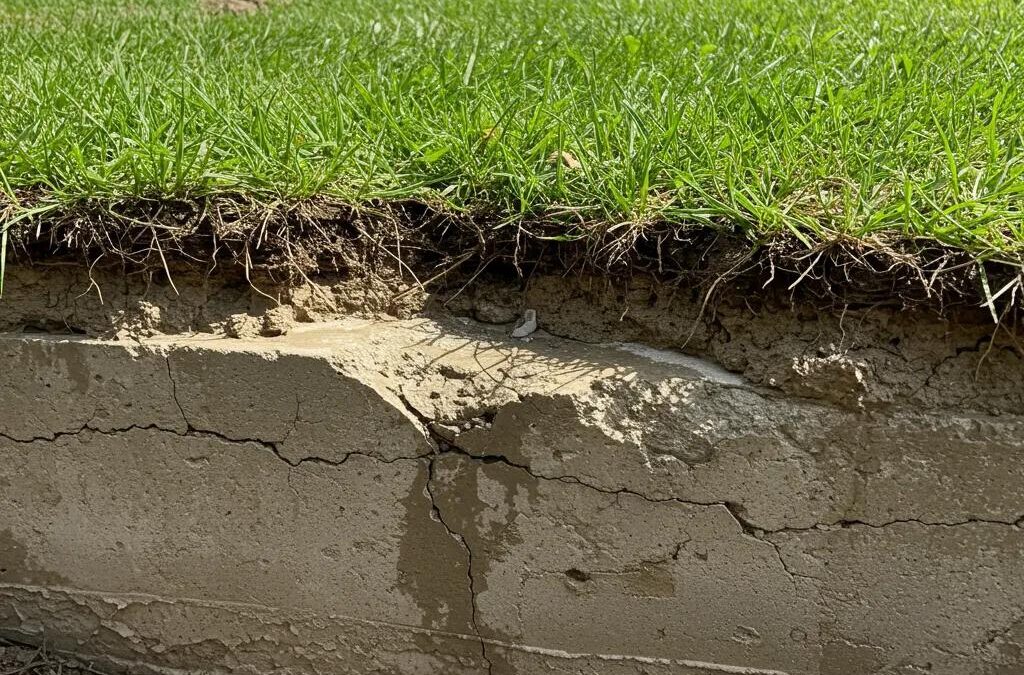Every year, countless homeowners in Madison face foundation leaks that compromise their home’s structure and lead to expensive water damage. Knowing how groundwater can seep into your concrete walls and floors empowers you to act fast, curb mold growth, and protect your property’s value. This guide covers everything you need to know about foundation leaks: what they are, why they happen in our area, how to spot them, professional repair and water removal options, cost considerations, preventative measures, and why The Steam Plus is Madison’s go-to restoration partner.
Follow this guide to learn how to identify cracks and moisture patterns specific to Dane County’s soil, compare basement waterproofing and crack injection techniques, understand emergency drying procedures, budget for sump pump installation or mold cleanup, implement year-round defenses, and choose a restoration company that offers 24/7 emergency service and complete solutions. With clear explanations, practical advice, and expert insights tailored to Madison’s climate, this article is your ultimate resource for managing foundation leaks.
What Exactly Are Foundation Leaks and How Do They Impact Madison Homes?
A foundation leak happens when water forces its way through cracks or openings in your concrete walls or floors, driven by the pressure of water in the soil. This infiltration weakens the concrete, can cause white powdery deposits (efflorescence), and creates a breeding ground for mold, ultimately shortening your home’s lifespan and harming your indoor air quality. For instance, if landscaping slopes toward your house, rainwater can pool against the foundation, pushing moisture into the joint where the wall meets the floor. Recognizing these entry points is key to choosing effective solutions instead of temporary fixes.
Common places for leaks include cracks in basement walls, floor joints, window wells, and deteriorating mortar in block foundations. If left unaddressed, even tiny hairline cracks can widen over time due to freezing and thawing, leading to dampness inside, warped walls, and that unmistakable musty smell. Taking care of these issues early prevents serious structural damage and sets the stage for successful waterproofing and restoration.
What Constitutes a Foundation Leak?
A foundation leak is essentially a breach in your concrete or masonry structure that allows soil moisture, groundwater, or surface water to enter your basement or crawl space. You might see these as vertical or horizontal cracks, leaky joints, damaged mortar, or porous block sections. The main culprit is hydrostatic pressure—water in the surrounding soil pushing against your foundation and finding the easiest path through any defect. Fixing these issues not only stops water from entering but also restores the foundation’s strength and prevents health problems from mold.
How Does Water Get Through Foundations in Madison?
Madison’s soil is rich in clay, which expands significantly when wet, and we get a good amount of rain each year—close to 36 inches on average. This combination means water saturates the ground and presses hard against foundation walls. When gutters are clogged, grading is poor, or drainage systems aren’t working, water can build up. During heavy downpours or rapid snowmelt, hydrostatic pressure spikes, forcing water through tiny cracks or unsealed block cores. Wisconsin’s freeze-thaw cycles then widen these openings, making our local weather a major factor in foundation leaks.
Where Do Foundation Leaks Typically Show Up?
Before we dive into repairs, let’s pinpoint the most common spots where leaks occur. Here are the usual suspects in Madison homes:
- Cracks in basement walls, often appearing as thin vertical lines or stair-step patterns
- Leaks where the basement wall meets the floor (cove joint)
- Cracks in the basement floor slab or gaps in expansion joints
- Water seeping in around window wells due to poor drainage
- Water entering through block foundation cores or deteriorated mortar
Knowing these vulnerable areas helps focus inspections and ensures that repair methods, like interior drainage systems or exterior sealing, target the actual source of the water intrusion.
What Are the Common Causes and Signs of Foundation Leaks in Madison, WI?
Foundation leaks in Madison are usually a mix of local soil conditions, harsh weather, and lapses in home maintenance. Recognizing the underlying causes and early warning signs means you can step in quickly before water damage restoration becomes a major project.
What Local Soil and Weather Conditions Cause Foundation Leaks?
Madison’s clay soil swells considerably when wet, pushing against foundation walls. Heavy rains, like the significant storm on August 8, 1906, saturate this clay, creating hydrostatic pressure that seeks an escape through imperfections in walls and floors. Temperature fluctuations cause freeze-thaw cycles that widen small cracks, and high groundwater levels in the spring keep the soil consistently damp. These combined local factors significantly increase the risk of foundation leaks compared to areas with better-draining soil.
How Do Poor Drainage and Plumbing Issues Lead to Leaks?
The integrity of your foundation also relies on how well water is managed around and within your home. Here are common drainage and plumbing failures that result in basement moisture:
- Gutters clogged with debris, causing roof water to pool near the foundation
- Downspouts that discharge water too close to the house’s exterior walls
- Damaged or collapsed French drain systems that can’t channel groundwater away
- Leaking interior plumbing pipes located near the foundation footings
Keeping gutters clear, ensuring downspouts extend far enough from the house, and maintaining functional interior drainage systems diverts water before it can build up pressure against your basement walls, reducing the chance of leaks.
What Are the Visible and Sensory Signs of Foundation Leaks?
Spotting foundation leaks early involves paying attention to both what you see and what you sense. Homeowners should look out for:
- Cracks in concrete walls or floors that run horizontally or diagonally
- Damp or wet patches appearing on basement surfaces
- Efflorescence, a white, powdery residue left behind as water evaporates
- A persistent musty smell, which often indicates mold spores
- Walls that appear to be bowing or bulging inward under pressure
How Can You Identify Mold Growth from Foundation Leaks?
Mold loves damp, poorly ventilated basements and can start growing within 24 to 48 hours after water enters. Spores can settle on concrete and other materials, appearing as fuzzy black, green, or white patches on walls and baseboards. Mold can cause respiratory issues and allergic reactions, making mold remediation a crucial step in addressing foundation leaks.
Mold Prevention: Prompt Mitigation of Water Intrusion… grade on the interior of basement or crawl space assemblies. … address leaks immediately to prevent mold proliferation. … remediation involves mold removal. To remove the …Mold: Causes, Health Effects and Clean-Up, Unknown Author, 2002
Why Is Catching Foundation Leaks Early So Important?
Addressing small leaks right away prevents cracks from getting bigger, limits mold growth, and stops further structural damage. Acting fast can save you thousands in water damage restoration, floor replacement, and prevent more serious foundation issues that require extensive excavation.
What Professional Repair Solutions Are Available for Foundation Leaks in Madison?
The best repair approach depends on where the leak is, the soil conditions, and your home’s design. Professional contractors offer a range of services that work together to create a robust defense against future leaks.
How Does Basement Waterproofing Prevent Future Leaks?
Basement waterproofing involves creating barriers and drainage systems to intercept water before it reaches your interior walls and floors. Here’s a look at common waterproofing methods:
| Method | Mechanism | Benefit |
|---|---|---|
| Interior French Drain System | Collects seeping water and directs it to a sump pit | Prevents water from pooling on the basement floor |
| Exterior Waterproofing Membrane | Seals the outside of foundation walls | Stops groundwater from reaching the concrete |
| Sump Pump Integration | Automatically pumps collected water away from the house | Reduces hydrostatic pressure and lowers flood risk |
Each method tackles different water entry points, and using them in combination provides a multi-layered defense. Combining interior drains with exterior coatings and a reliable sump pump addresses both soil pressure and surface water effectively.
What Are the Most Effective Foundation Crack Repair Methods?

Both epoxy and urethane injections can permanently seal cracks, but they are best suited for different situations:
- Epoxy injection bonds cracked concrete together, restoring its structural integrity and load-bearing strength.
- Urethane injection expands within the crack, effectively blocking active water leaks while remaining flexible.
For larger or deeper cracks, carbon fiber straps can be used to reinforce walls and prevent them from bowing under soil pressure. The right repair method depends on the crack’s size, how wet it is, and the long-term stability needed.
Evaluation of Injection Materials for Concrete Crack Repair This laboratory study aimed to evaluate injection materials for filling and repairing deep, narrow cracks in massive concrete structures. While the primary focus was on epoxies, high-molecular-weight methacrylates, ultrafine cements, and polyurethanes were also investigated. A laboratory test program was designed to assess key properties relevant to injection materials, including viscosity, surface tension, gel time, penetration, and bond strength to wet concrete. Evaluation of Injection Materials for the Repair of Deep Cracks in Concrete Structures. Repair, Evaluation, Maintenance, and Rehabilitation Research Program, 1995
Why Are Sump Pump Installation and Maintenance So Important?
A sump pump is your home’s first line of defense against basement flooding. It removes groundwater that collects in an interior drainage system. Key advantages include:
- Quickly removes water during heavy rain or rapid snowmelt
- Battery backup options ensure it keeps working even during power outages
- Reduces hydrostatic pressure, helping to extend the life of your foundation
Regular maintenance—like testing the pump’s activation, checking discharge lines, and replacing worn parts—ensures it will function when you need it most.
How Does Water Damage Restoration Work After a Foundation Leak in Madison?
When foundation leaks result in standing water or high humidity, professional restoration services are needed to make the space safe, dry, and free of contaminants.
What Are the Steps in Emergency Water Extraction and Drying?
Effective restoration follows a specific process:
- Assessment and Safety – Pinpoint the water source, determine the water category, and address any electrical hazards.
- Water Extraction – Use powerful pumps and vacuums to remove all standing water.
- Structural Drying – Employ air movers, dehumidifiers, and moisture meters to thoroughly dry walls, floors, and structural components.
- Monitoring – Continuously track moisture levels until they return to safe, normal ranges.
Following these steps minimizes the risk of mold growth and prepares the area for necessary repairs, directly complementing foundation sealing efforts.
How Is Mold Remediation Handled After Water Damage?
Containment barriers are set up to isolate affected areas and prevent mold spores from spreading. Technicians then remove mold-damaged materials, clean the air with HEPA filters, and apply antimicrobial treatments to surfaces. Air quality testing is performed to confirm that spore counts have returned to normal background levels, ensuring the space is safe to reoccupy.
When Is Floor Removal and Restoration Necessary?
Porous flooring materials like carpet, wood, or tile often need to be removed to allow for thorough drying of the subfloor and to prevent mold from returning. The Steam Plus offers carpet cleaning and restoration services, focusing on salvaging padding and fibers where possible. Tile and hardwood may require professional sanding, reinstallation, or even subfloor replacement to ensure a lasting repair.
How Much Does It Cost to Fix Foundation Leaks in Madison, WI?
The cost of repairs can vary significantly depending on how severe the leak is, the methods used, and any necessary restoration or mold remediation services.
What Factors Influence Foundation Leak Repair Costs?
Several elements contribute to the overall expense:
- Leak Severity and Location – Deeper hydrostatic cracks that are harder to access will cost more to seal.
- Repair Method – Interior drainage systems and exterior waterproofing membranes have different material and labor requirements.
- Mold Remediation – Testing, containment, and air filtration add to the project’s scope and cost.
- Floor Restoration – Removing and replacing carpets or hardwood floors will increase the budget.
Understanding these factors helps homeowners set realistic expectations when getting quotes from contractors.
How Does Insurance Affect Repair Expenses?
Your homeowner’s insurance policy might cover sudden foundation leaks caused by plumbing failures or storm damage, but it typically won’t cover gradual seepage resulting from poor maintenance. Deductibles and coverage limits vary, so documenting the damage promptly and providing professional assessments can improve your chances of a successful insurance claim.
What Are Typical Price Ranges for Common Repairs in Madison?
| Service | Typical Cost Range | Notes |
|---|---|---|
| Interior French Drain Installation | $2,500–$6,000 | Varies based on basement square footage |
| Exterior Waterproofing Membrane | $5,000–$10,000 | Includes excavation and backfilling costs |
| Epoxy Crack Injection | $300–$800 per crack | Depends on crack length and how easy it is to access |
| Sump Pump System | $1,200–$3,000 | Includes pump, basin, and optional battery backup |
These price ranges provide a helpful starting point for budgeting and comparing proposals, guiding homeowners toward making informed decisions.
How Can Madison Homeowners Prevent Future Foundation Leaks?
A proactive maintenance plan can significantly reduce the likelihood of leaks, keep your foundation in good shape, and minimize the need for future restoration work.
What Seasonal Maintenance Helps Avoid Foundation Leaks?
Regular upkeep tailored to Madison’s climate cycles is essential:
- Spring: Clean out gutters, check downspout extensions, and test your sump pump.
- Summer: Ensure soil slopes away from the foundation and service any interior French drains.
- Fall: Seal any minor cracks with masonry sealant and verify that exterior membranes are intact.
- Winter: Keep an eye on snow accumulation near window wells and clear ice dams that could redirect meltwater.
Consistent seasonal checks help you spot early warning signs and maintain your water diversion systems before problems become serious.
Prevention of Foundation Leaks and Moisture Damage Moisture issues during cooling seasons in hot, humid climates can arise from sources other than direct water seepage or foundation leakage. One strategy to prevent damage to attic sheathing involves…Recommendations for remedial and preventive actions for existing residential buildings, 1994
How Do Local Building Codes and Climate Impact Prevention?
Madison’s building codes mandate specific grading slopes and downspout setbacks to protect foundations. Following these codes, along with requirements for footing depth and approved drainage materials, ensures your home is built to withstand the region’s freeze-thaw climate patterns and resist leaks.
When Should You Schedule Professional Inspections?
Having foundation specialists conduct inspections annually or every two years can reveal developing cracks, drainage blockages, or soil settlement before they lead to leaks. Early professional assessments often uncover hidden issues, connecting regular maintenance to long-term savings on water damage restoration and mold remediation.
Why Choose The Steam Plus for Foundation Leak Repair and Restoration in Madison, WI?
Partnering with a local expert that offers a full range of services makes dealing with leak repair, water extraction, and post-damage restoration much simpler, all under one trusted provider.
What Local Experience Does The Steam Plus Bring to Madison Homeowners?
Having served Madison, Sun Prairie, and Middleton for years, The Steam Plus deeply understands the area’s clay-rich soils, heavy rainfall patterns, and local building practices. This extensive local knowledge allows for precise identification of water intrusion points and the development of customized solutions that outperform generic waterproofing methods.
What Comprehensive Services Does The Steam Plus Offer?
The Steam Plus provides a complete restoration process, including:
- Foundation leak repair and installation of interior drainage systems
- Emergency water extraction and structural drying
- Mold containment, removal, and air quality testing
- Floor removal, carpet cleaning, and hardwood restoration
How Does The Steam Plus Ensure Rapid Emergency Response?
Our dedicated 24/7 hotline and strategically located teams mean we can typically arrive within hours of a water emergency. Swift water removal and drying minimize structural stress and prevent mold growth, demonstrating a level of responsiveness that limits damage and protects your family’s health.
Every step in managing foundation leaks, from understanding soil pressure to selecting the right repair method, is vital for protecting Madison homes.
By performing seasonal maintenance, understanding repair costs, and working with a full-service restoration expert like The Steam Plus, homeowners can prevent minor seepage from turning into major structural problems.
Proactive inspections and professional waterproofing ensure that each repair strengthens your foundation’s longevity and maintains healthy indoor air quality.
When emergencies strike, reliable water extraction, mold remediation, and floor restoration services restore safety and comfort, transforming a potentially devastating leak into a manageable situation.








